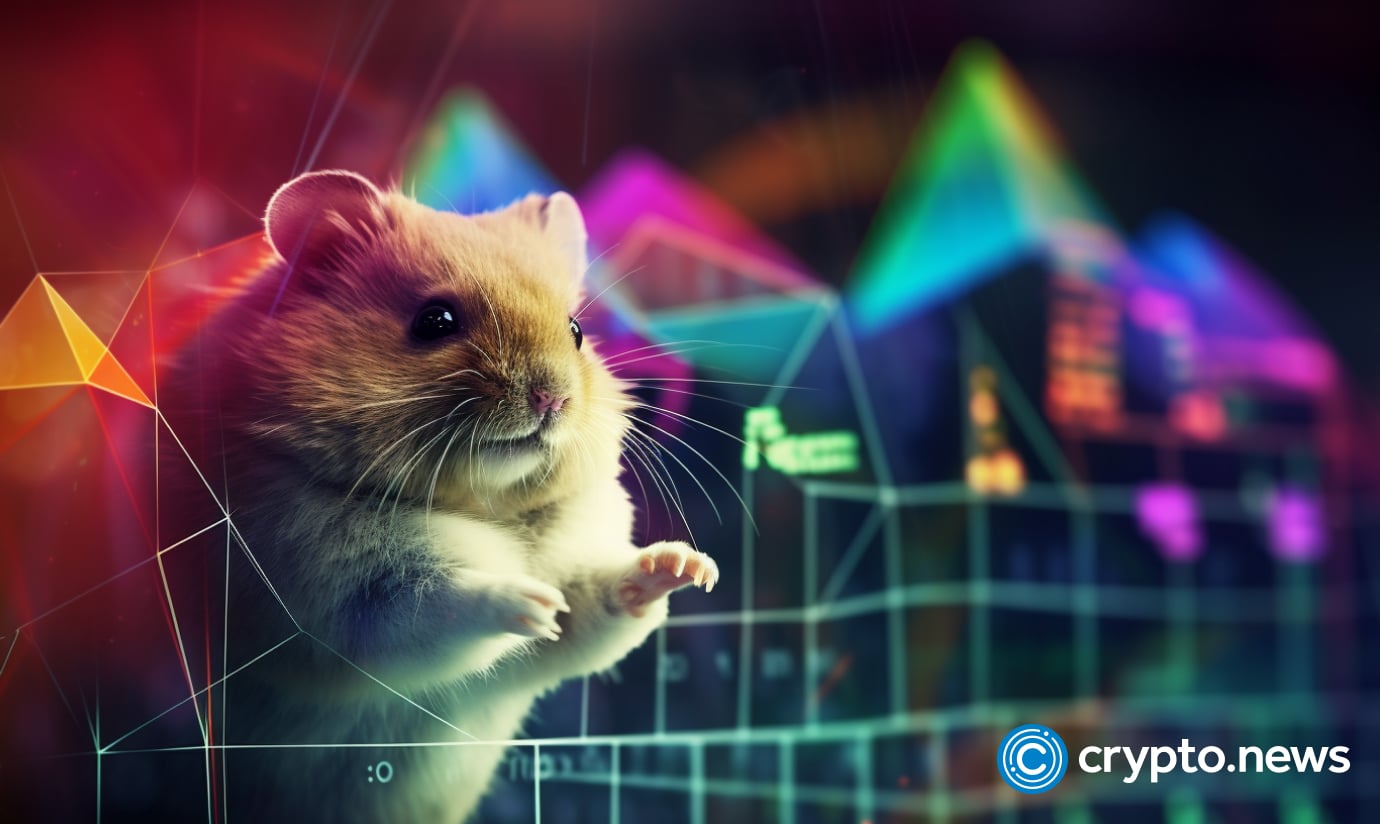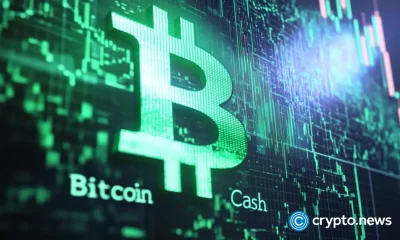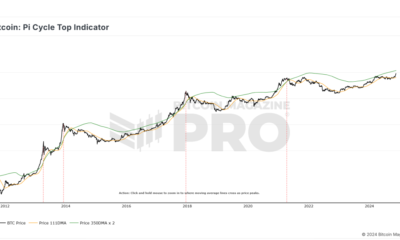blockchain games
Hamster Kombat Ended in a Mass Exodus of 260 Million Players
Published
2 weeks agoon
By
admin

Did Hamster Kombat’s viral rise lead to its own downfall? How did 260 million players vanish in months, leaving the game a shadow of its former self?
From boom to dust
Hamster Kombat (HMSTR), a once-celebrated tap-to-earn game on Telegram, seemed destined for blockchain gaming fame, amassing a jaw-dropping 300 million users within months of its launch in March 2024.
But in a surprising twist, this viral sensation has seen an 86% nosedive in active users, dropping to just 41 million by November 2024 and facing one of the most dramatic declines in crypto gaming history.
.@hamster_kombat loses nearly 260 million players in just three months
Hamster Kombat, the tap-to-earn Telegram game that boasted a massive 300-million-strong user base back in August, has reportedly shed 259 million players.
The game’s active monthly player count currently… pic.twitter.com/vVfwhbI4E6
— ICO Drops (@ICODrops) November 4, 2024
The game’s token, HMSTR, has also plummeted in value by over 76%, sliding from its September high of $0.01004 to just $0.0024 as of Nov. 5, casting doubts over the project’s stability.
Behind this exodus lie a series of interconnected setbacks: delayed airdrops, poor user experience, government criticisms, and controversial player bans.
Could the game’s ambitious goals have been the very seeds of its undoing? Let’s delve into the numbers, the strategies, and the backlash to find out what led to Hamster Kombat’s colossal fall from grace.
The rise and promise of Hamster Kombat
Hamster Kombat launched with an ambitious promise: to make blockchain gaming accessible to everyone. A big part of the game’s appeal lies in its simplicity. No need for gaming consoles, advanced computers, or complex controls — players simply tapped, and in return, they earned.
Even Telegram’s CEO, Pavel Durov, hailed it as “the fastest-growing digital service in the world,” citing its potential to redefine how people interacted with blockchain technology.
People from all over the world were suddenly part of this booming virtual ecosystem, where tapping became the new mining, and the tokens they collected had real value attached.
But the game itself couldn’t keep players engaged. The initial excitement over the tap-to-earn model quickly faded as players found the gameplay repetitive and shallow.
With no fresh challenges, Hamster Kombat began to lose its appeal, leaving users with little reason to return, especially as the HMSTR token kept losing value.
The AI-generated graphics, which initially seemed quirky, were also criticized for feeling cheap and uninspired, adding to the perception that Hamster Kombat was more of a cash grab than a well-crafted gaming experience.
The simplicity that first drew users in became a source of frustration, and the game’s high hopes for sustainability faced challenges that even a massive user base couldn’t fix.
The airdrop disappointment and the backlash of bans
One of Hamster Kombat’s most eagerly awaited events was its token airdrop in late September, intended as a reward for player loyalty and engagement.
With nearly 129 million players eligible to claim HMSTR tokens, expectations ran high. But what was meant to be a celebratory event ended up driving players away in droves.
The airdrop left many users frustrated, not just because of delays but due to the surprisingly low value of their rewards.
Some players who had spent hours grinding the game found their earnings amounted to just $1 to $10 — a fraction of what they’d hoped for, leading some to label the airdrop as “dust.”
To make matters worse, the rollout of the airdrop was marred by delays and technical glitches. Originally promised as a straightforward distribution, the airdrop faced several postponements, testing players’ patience.
By the time it finally happened, the discontent among the user base was palpable. Many players took to social media to vent their frustrations, some claiming they felt deceived by what they saw as broken promises.
This backlash severely damaged the game’s reputation, transforming the airdrop from an incentive to a point of contention.
The controversy didn’t end there. Hamster Kombat introduced a new anti-cheat system alongside the airdrop, aiming to curb fraudulent activities.
While intended to protect genuine players, this system ended up banning around 2.3 million accounts and confiscating approximately 6.8 billion HMSTR tokens. Many players felt blindsided by these sudden restrictions, as even legitimate users were caught in the dragnet.
Some felt that the sweeping bans were too harsh, and the confiscations only added to the resentment, leaving a large chunk of the player base feeling alienated and mistreated.
The fallout was swift. The airdrop disappointment, combined with the massive bans, fueled a wave of user departures. By early November, Hamster Kombat’s once-formidable user base had dwindled to just 41 million monthly active players, a fraction of its 300 million peak.
Government scrutiny and the ripple effect of public doubt
Hamster Kombat’s rapid rise wasn’t just on players’ radar — it also attracted the attention of governments, and not always in a positive way.
In some regions, officials expressed concern over the game’s influence, viewing it as more than just a harmless pastime. As its user base swelled, so did the scrutiny, with some authorities labeling the game as a “disruptive force” in their societies.
In Iran, the backlash was particularly strong. The game caught the attention of the country’s military officials, who were concerned that Hamster Kombat was drawing attention away from political matters.
One Iranian military deputy chief went so far as to call it a “soft tool” being used by the West to distract citizens from national priorities and weaken the country’s religious governance, positioning it as a digital disruptor with intentions beyond simple entertainment.
The situation was similar in Russia, where the chairman of the State Duma Committee took an even harsher stance, branding Hamster Kombat as a “scam”, and called for an outright ban.
The developers of Hamster Kombat have also had to address their connection with Gotbit, a crypto market maker now under investigation for fraud in the U.S.
As the authorities filed charges against Gotbit for market manipulation, Hamster Kombat publicly distanced itself from the company.
Dear CEOs,
We are committed to ensuring transparency within the Hamster Ecosystem.
In light of recent news regarding Gotbit, we want to clarify that Hamster Kombat has never worked with Gotbit as a market maker.
— Hamster Kombat (@hamster_kombat) October 12, 2024
Despite these efforts, users have continued to question the stability of the HMSTR token, which has already experienced a stark drop in value.
What’s next for HMSTR?
The sharp downturn in Hamster Kombat’s player base and token price has left many in the crypto community asking: is this just a stumble, or has the game reached a point of no return?
One of the most pressing concerns is a breakdown in trust, with disappointed users feeling that Hamster Kombat has “betrayed the trust of its community.”
❌ Enough is Enough Hamster Kombat ❌
Hamster Kombat has betrayed the trust of its community through deceptive practices, prioritizing influencers over genuine users. It’s time to hold them accountable and demand justice.
😥😥🙏🙏💯🤝 pic.twitter.com/nBaGHRPYQz— Caleb (@Canny5b23n) November 2, 2024
The backlash stems from a perception that the game prioritized influencer partnerships and flashy marketing over a genuinely user-focused experience.
Many early adopters, who initially hoped for long-term rewards, are now disillusioned by broken promises, delayed airdrops, and the steady devaluation of the token.
One disappointed player noted they left after the first season, saying they had “so much hope” for the game but ultimately felt let down by the experience.
I personally left the game after the disappointed me in the first season, i had so much hope but they made it short 🥺
— Millie (@origanalybohay) November 5, 2024
Another major worry has been the ongoing decline in the value of the HMSTR token. As one observer put it, the token’s price chart is “in freefall,” with many users predicting that exchange delistings are “probably around the corner.”
This prediction isn’t baseless; projects unable to sustain interest or stabilize token value often find themselves sidelined by major exchanges due to low trading volume and high volatility.
For Hamster Kombat, rebuilding user trust and stabilizing the HMSTR token will demand not only operational adjustments but also clear communication. This includes rethinking gameplay mechanics, enhancing reward quality, and building genuine engagement with the community.
The broader takeaway here is that crypto games must go beyond promises to deliver real value if they want to survive the increasingly skeptical eyes of their audiences.
Source link
You may like


Bitcoin Cash eyes 18% rally


Rare Shiba Inu Price Patterns Hint SHIB Could Double Soon


The Bitcoin Pi Cycle Top Indicator: How to Accurately Time Market Cycle Peaks


Bitcoin Approaches $100K; Retail Investors Stay Steady


Solana Hits New ATH On Huge Whale Accumulation, More Gains Ahead?


Microsoft Should Buy $78 Billion Worth of Bitcoin
blockchain games
HashCats prepares for Token Generation Event after completing mining season
Published
16 hours agoon
November 21, 2024By
admin

HashCats, a tap-to-earn miner game, is concluding its first season and shifting focus to its upcoming Token Generation Event.
With nearly five million players engaged in the game’s first six months, HashCats has announced a $500,000 giveaway in collaboration with its partner Choise.ai to reward players ahead of this next phase, according to a release shared with crypto.news.
T2E games, which allow users to earn cryptocurrency by playing, have gained attention but faced challenges in maintaining long-term engagement. Games like Hamster Kombat and Catizen (CATI) initially sparked hype but have struggled to sustain user interest.
HashCats is trying to buck this trend by expanding its ecosystem and enhancing player incentives.
HashCats background
Tap-to-earn games let users generate cryptocurrency by playing simple games. In HashCats, players mine $HASH tokens by tapping their screens and upgrading virtual mining equipment. These tokens can then be converted into cryptocurrency or used within the game’s ecosystem.
Unlike traditional games that charge for upgrades, T2E games aim to provide a potential income stream for players.
Season 1 of HashCats introduced basic mining mechanics, enabling players to use a single virtual ASIC miner designed for mining specific digital currencies based on their hashing algorithms.
According to the release, Season 2 will expand this concept, enabling players to manage a full mining farm and introducing Secret Points, which boost TGE rewards. Players from Season 1 who accumulated SP through contests and giveaways will gain an advantage in the new phase.
HashCats and Choise.ai Collaboration
The partnership with Choise.ai, a platform that merges traditional finance with blockchain, adds an extra layer of incentives.
The ongoing $500,000 giveaway includes events like the “Wheel of Fortune” contest, where players can win CHO tokens. Choise.ai also plans to launch Visa and Mastercard options tailored for HashCats players.
Source link
blockchain games
Did Jump Trading Just ‘Fracture’ the Trust of the Crypto industry?
Published
1 month agoon
October 18, 2024By
admin

Is Jump Trading responsible for the collapse of DIO tokens? How did a market maker supposedly take advantage of a partnership with Fracture Labs to pocket millions and leave chaos behind?
Jump Trading, a prominent name in the crypto trading space, is now entangled in a legal battle. Fracture Labs, the creators of the blockchain-based game Decimated, has sued Jump, accusing the firm of executing a “pump and dump” scheme.
At the heart of the lawsuit, Fracture Labs claims Jump Trading exploited its role as a market maker to inflate the value of its DIO gaming token artificially. Once the price peaked, Jump allegedly sold off its holdings, triggering a sharp price decline.
How does a collaboration designed to promote a token’s success devolve into allegations of fraud and manipulation? Let’s break down the sequence of events leading up to the lawsuit and why it has drawn so much attention.
What happened between Jump Trading and Fracture Labs?
On Oct. 15, Fracture Labs filed a lawsuit against Jump Trading in an Illinois district court, accusing the firm of breaching their agreement and manipulating the DIO token.
To fully grasp the situation, we need to revisit 2021. During this time, Fracture Labs had just launched its DIO token to support its blockchain game, Decimated, and entered a partnership with Jump Trading to facilitate the token’s market introduction.
Jump Trading agreed to serve as a market maker—a role that involves providing liquidity to ensure smooth trading and price stability for the token. Market makers typically buy and sell assets to maintain balanced trading conditions, especially for newly launched tokens like DIO.
As part of the arrangement, Fracture Labs loaned 10 million DIO tokens to Jump, valued at approximately $500,000 at the time. The expectation was that Jump would assist in the token’s debut on the crypto exchange Huobi (HT), now known as HTX.
In addition to the loaned tokens, Fracture Labs sent 6 million more tokens directly to HTX, worth about $300,000, as part of its broader marketing campaign. With these preparations in place, everything seemed primed for a successful launch.
HTX played its part by heavily promoting the DIO token and leveraging influencers and social media campaigns to boost its visibility.
The strategy appeared successful — perhaps overly so. The price of DIO surged to $0.98, dramatically raising the value of Jump’s 10 million DIO holdings from $500,000 to a staggering $9.8 million in a short period.
For Jump Trading, this price surge represented an enormous windfall. The 10 million tokens they had borrowed were suddenly worth nearly $10 million. However, what followed is where the allegations of manipulation arise.
Fracture Labs alleges that Jump Trading saw the soaring price as a profit-making opportunity. Instead of continuing to provide liquidity and stabilize the token, Jump allegedly began selling off its DIO holdings in large quantities.
This mass sell-off caused a steep drop in DIO’s value, plummeting from nearly a dollar to just $0.005—a dramatic collapse that decimated the token’s worth.
The lawsuit further claims that after selling the tokens at their peak, Jump repurchased the devalued DIO tokens for just $53,000. This allowed Jump to return the 10 million tokens it had borrowed, fulfilling its obligation to Fracture Labs, all while pocketing millions in profit.
Breach of trust and legal fallout
The collapse of DIO’s price had devastating consequences for Fracture Labs. According to the lawsuit, the sudden and severe drop in value crippled the company’s ability to attract new investors or sustain interest in the DIO token.
Adding to their troubles, Fracture Labs had deposited 1.5 million Tether (USDT) into an HTX holding account as a safeguard against accusations of market manipulation. This deposit was intended to reassure the market that Fracture Labs would not manipulate DIO’s price during its first 180 days of trading.
However, due to the extreme price volatility that Fracture Labs claims were triggered by Jump Trading’s actions, HTX allegedly refused to return most of the USDT deposit. This left Fracture Labs with not only a devalued token but also a substantial financial loss from their USDT deposit.
Fracture Labs is now accusing Jump Trading of fraud, civil conspiracy, breach of contract, and breach of fiduciary duty. They assert that Jump Trading abused the trust placed in them as a market maker, using their privileged position to manipulate DIO’s price for personal gain.
The lawsuit seeks damages, the return of the profits that Jump allegedly made from the scheme, and a jury trial to settle the matter. Interestingly, HTX is not named as a defendant in the lawsuit.
Jump Trading’s troubled past
The controversy surrounding Jump Trading is not new, as the firm has been under regulatory scrutiny multiple times in recent years.
In fact, both Jump Trading and its crypto arm, Jump Crypto, have faced several legal and regulatory challenges, raising concerns about their operations in the crypto market.
One of the more prominent cases surfaced in November 2023, when Jump Crypto’s involvement came under the spotlight in the U.S. Securities and Exchange Commission’s lawsuit against Terraform Labs.
The lawsuit, originally filed in February 2023, alleged that Terraform Labs and its former CEO, Do Kwon, engaged in fraudulent activities and sold unregistered securities, focusing on their failed algorithmic stablecoin, TerraUSD (UST).
The collapse of UST in May 2022 led to billions of dollars in losses and significant turmoil across the broader crypto market.
According to the SEC, when UST first began losing its dollar peg in 2021, Terraform Labs collaborated with Jump Crypto to artificially boost the stablecoin’s value.
The regulator claimed that Jump Crypto purchased large amounts of UST to restore its price, temporarily stabilizing the asset. However, when UST experienced its final collapse in May 2022, no similar intervention took place.
Terraform Labs, however, denied these claims, stating that Jump Crypto’s actions had no bearing on UST’s earlier recovery.
In April 2024, Terraform Labs reached a settlement with the SEC, agreeing to pay $4.47 billion after a jury found them liable for defrauding investors. The settlement included $420 million in civil fines, $3.6 billion in disgorgement, and $467 million in interest.
Although Jump Crypto was linked to UST’s earlier recovery efforts, it was neither charged nor formally implicated in any wrongdoing as part of the settlement.
By June 2024, Jump Crypto found itself under investigation by another U.S. regulatory body—the Commodity Futures Trading Commission. The CFTC launched a probe into Jump Crypto, reportedly scrutinizing its trading and investment activities within the crypto sector. Kanav Kariya, the firm’s former president, resigned just days later.
While the specifics of the investigation remain confidential, and no official allegations have been made, the probe reflects a broader push by U.S. regulators, including the CFTC, to intensify their enforcement actions against crypto firms throughout 2023 and 2024.
What to expect next?
If Fracture Labs succeeds in proving Jump Trading’s misconduct, it could trigger a major shift across the crypto industry, leading to tighter regulations and increased scrutiny of market makers.
However, this case is more than just one lawsuit. Governments, especially in the U.S. and Europe, are actively developing policies aimed at curbing market abuses. This case might provide regulators with the prime example they need to justify stricter oversight of market makers.
Additionally, token creators may start advocating for decentralized solutions or pushing for more restrictive contracts that limit the influence of market makers.
For the crypto industry to truly mature, this could be a crucial moment that compels everyone — projects, exchanges, and investors — to reevaluate how tokens are launched and managed, placing a greater emphasis on fairness and trust.
Source link
blockchain games
Telegram gaming sees NFT and user engagement boom in Q3 2024: report
Published
1 month agoon
October 18, 2024By
admin

According to a new report from Helika on Telegram games, engagement with NFTs and longer player sessions increased in Telegram’s gaming ecosystem during Q3 2024.
The number of unique wallets transferring NFTs surged from 200,000 to over 1 million during the quarter, per the report, with 600,000 wallets actively involved in NFT transactions within games.
Players also spend more time playing Telegram games. The report showed that average session lengths nearly doubled from 2.8 to 6.7 minutes, suggesting that improved game design keeps users engaged.
Regional data indicates a shift in Telegram’s gaming audience compared to other Web3 platforms, with 55.91% of players coming from Europe, in contrast to Asia and Latin America, where Web3 gaming traditionally thrives.
Increased engagement on Telegram games
Per the report, Catizen completed its first airdrops, distributing 34% of its total token allocation, which included 150 million tokens distributed in September 2024 alone. The airdrop increased activity, reflecting its integration into Telegram.
In September, Binance listed Catizen on the Binance Launchpool, allowing users to farm the gaming bot’s native token ahead of trading.
Like Catizen, Gamee experienced a 300% increase in volume and transactions month over month, showing more players and engagement. X Empire attracted nearly 48 million players, with 18 million connecting their wallets to engage with the game’s features.
According to the report, Rocky Rabbit had 30 million players, and Banana reached 10 million users by October. Wonton users surpassed 1 million within its first week.
However, the report also highlighted challenges faced by developers as new games flood the platform. Small development teams struggle with limited marketing budgets and attracting users. Developers are expanding game genres and introducing a wider variety of experiences, such as simulations, RPGs, and puzzles, indicating that Telegram’s gaming ecosystem is evolving beyond simple, casual games.
Source link

Bitcoin Cash eyes 18% rally

Rare Shiba Inu Price Patterns Hint SHIB Could Double Soon

The Bitcoin Pi Cycle Top Indicator: How to Accurately Time Market Cycle Peaks
Bitcoin Breakout At $93,257 Barrier Fuels Bullish Optimism

Bitcoin Approaches $100K; Retail Investors Stay Steady

Solana Hits New ATH On Huge Whale Accumulation, More Gains Ahead?

Microsoft Should Buy $78 Billion Worth of Bitcoin

Ethereum Believers May Be Staring Down Opportunity As ETH Reaches Another Low Against Bitcoin: CryptoQuant CEO

UK government is ready for crypto regulations next year

“Crypto Dad” Chris Giancarlo Emerges Top For White House Crypto Czar Role

Bitcoin Nears $100,000 As Trump Council Expected To Implement BTC Reserve

Know Your Missiles: Russia’s Experimental Hypersonic Missile Is A New Kind of Killing Machine

Polkadot investor predicts a 30,000% rally for this $0.04 token by 2025

Donald Trump Proposed Crypto Advisory Council To Set Up Strategic Bitcoin Reserve

Want Greater Bitcoin Adoption? Engage With Your Government.
182267361726451435

Top Crypto News Headlines of The Week

Why Did Trump Change His Mind on Bitcoin?

New U.S. president must bring clarity to crypto regulation, analyst says

Ethereum, Solana touch key levels as Bitcoin spikes

Bitcoin Open-Source Development Takes The Stage In Nashville

Will XRP Price Defend $0.5 Support If SEC Decides to Appeal?

Bitcoin 20% Surge In 3 Weeks Teases Record-Breaking Potential

Ethereum Crash A Buying Opportunity? This Whale Thinks So

Shiba Inu Price Slips 4% as 3500% Burn Rate Surge Fails to Halt Correction

‘Hamster Kombat’ Airdrop Delayed as Pre-Market Trading for Telegram Game Expands

Washington financial watchdog warns of scam involving fake crypto ‘professors’

Citigroup Executive Steps Down To Explore Crypto
Mostbet Güvenilir Mi – Casino Bonus 2024

Bitcoin flashes indicator that often precedes higher prices: CryptoQuant
Trending

 2 months ago
2 months ago182267361726451435

 24/7 Cryptocurrency News3 months ago
24/7 Cryptocurrency News3 months agoTop Crypto News Headlines of The Week

 Donald Trump4 months ago
Donald Trump4 months agoWhy Did Trump Change His Mind on Bitcoin?

 News3 months ago
News3 months agoNew U.S. president must bring clarity to crypto regulation, analyst says

 Bitcoin4 months ago
Bitcoin4 months agoEthereum, Solana touch key levels as Bitcoin spikes

 Opinion4 months ago
Opinion4 months agoBitcoin Open-Source Development Takes The Stage In Nashville

 Price analysis3 months ago
Price analysis3 months agoWill XRP Price Defend $0.5 Support If SEC Decides to Appeal?

 Bitcoin4 months ago
Bitcoin4 months agoBitcoin 20% Surge In 3 Weeks Teases Record-Breaking Potential


